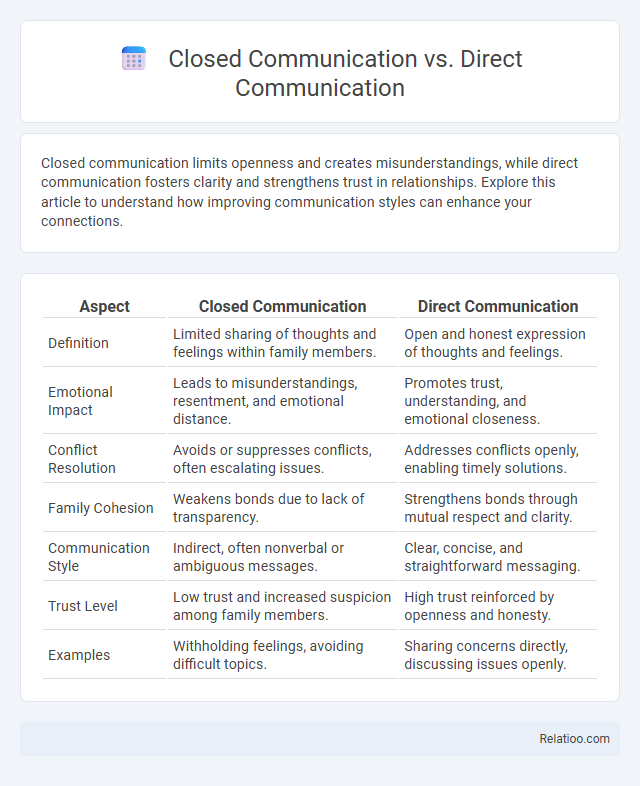Closed communication limits openness and creates misunderstandings, while direct communication fosters clarity and strengthens trust in relationships. Explore this article to understand how improving communication styles can enhance your connections.
Table of Comparison
| Aspect | Closed Communication | Direct Communication |
|---|---|---|
| Definition | Limited sharing of thoughts and feelings within family members. | Open and honest expression of thoughts and feelings. |
| Emotional Impact | Leads to misunderstandings, resentment, and emotional distance. | Promotes trust, understanding, and emotional closeness. |
| Conflict Resolution | Avoids or suppresses conflicts, often escalating issues. | Addresses conflicts openly, enabling timely solutions. |
| Family Cohesion | Weakens bonds due to lack of transparency. | Strengthens bonds through mutual respect and clarity. |
| Communication Style | Indirect, often nonverbal or ambiguous messages. | Clear, concise, and straightforward messaging. |
| Trust Level | Low trust and increased suspicion among family members. | High trust reinforced by openness and honesty. |
| Examples | Withholding feelings, avoiding difficult topics. | Sharing concerns directly, discussing issues openly. |
Understanding Closed Communication
Closed Communication restricts the flow of information, often resulting in misunderstandings and limited collaboration. It differs from Direct Communication, which promotes clarity and openness, enabling effective exchange of ideas and feedback. Understanding Closed Communication helps You recognize barriers that impede trust and teamwork, improving your ability to foster transparent dialogue.
Defining Direct Communication
Direct communication involves expressing thoughts and feelings clearly, openly, and honestly, minimizing misunderstandings and promoting transparency. In contrast, closed communication is characterized by withholding information, avoiding openness, and often creating barriers to effective interaction. Comparing these styles highlights how direct communication fosters trust and clarity, whereas closed communication can lead to confusion and mistrust.
Key Differences Between Closed and Direct Communication
Closed communication limits information flow by restricting feedback and sharing only necessary details, often creating ambiguity and hindering collaboration. Direct communication, by contrast, emphasizes clear, straightforward messages with open feedback, promoting transparency and efficient problem-solving. Key differences include openness, clarity, and the level of listener engagement, where direct communication encourages active participation while closed communication maintains control over information dissemination.
Advantages of Closed Communication
Closed communication offers enhanced confidentiality by limiting information flow to trusted individuals, reducing the risk of leaks and misunderstandings. Your team benefits from increased control over sensitive data, fostering a secure environment crucial for strategic decision-making. This communication style helps maintain focus and prevents distractions by narrowing the conversation to essential stakeholders.
Benefits of Direct Communication
Direct communication enhances clarity and reduces misunderstandings by conveying messages transparently and efficiently. It fosters trust and strengthens relationships by encouraging openness and immediate feedback between parties. Unlike closed communication, which limits information flow, direct communication drives collaboration and problem-solving through active engagement and honest dialogue.
Challenges of Closed Communication Styles
Closed communication styles often lead to misunderstandings and reduced collaboration as important information is withheld or only partially shared. Individuals employing closed communication may struggle with trust issues, resulting in decreased morale and lower team productivity. Such communication barriers hinder problem-solving and innovation, creating challenges for organizational growth and interpersonal relationships.
Potential Drawbacks of Direct Communication
Direct communication promotes clarity and efficiency by expressing thoughts openly, but it can risk offending recipients or damaging relationships if perceived as blunt or insensitive. Closed communication, characterized by withholding information, may limit misunderstandings but often leads to confusion, mistrust, and reduced collaboration. Mixing closed with direct communication styles can exacerbate conflicts, as inconsistent messaging undermines transparency and employee morale.
Choosing the Right Communication Style for Your Team
Selecting the right communication style for your team significantly impacts collaboration and productivity, with direct communication fostering clarity and efficiency through straightforward exchanges. Closed communication limits information flow, potentially causing misunderstandings and reduced teamwork, while open communication encourages transparency and trust, enhancing problem-solving and innovation. Tailoring the approach based on team dynamics and project goals ensures effective messaging that aligns with organizational objectives and individual preferences.
Impact of Communication Styles on Workplace Culture
Closed communication limits information flow, creating misunderstandings and reducing trust among team members, which harms workplace culture by fostering isolation and inefficiency. Direct communication promotes clarity and transparency, encouraging openness that enhances collaboration, employee engagement, and a positive organizational environment. In contrast, overly closed communication stifles feedback and innovation, while direct communication cultivates accountability and stronger interpersonal relationships, driving overall team performance.
Strategies to Balance Closed and Direct Communication
Balancing closed communication and direct communication involves implementing strategies that combine clarity with discretion to optimize information flow within organizations. Employing a structured feedback system allows for targeted sharing of sensitive information while promoting open dialogue where transparency enhances collaboration and trust. Integrating communication training focusing on active listening, emotional intelligence, and context-awareness ensures that messages are conveyed appropriately, adapting to different situations and audience needs.

Infographic: Closed Communication vs Direct Communication
 relatioo.com
relatioo.com